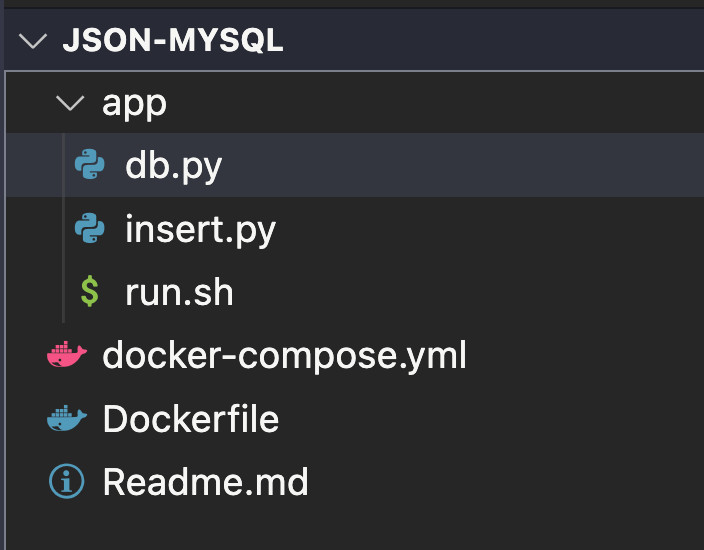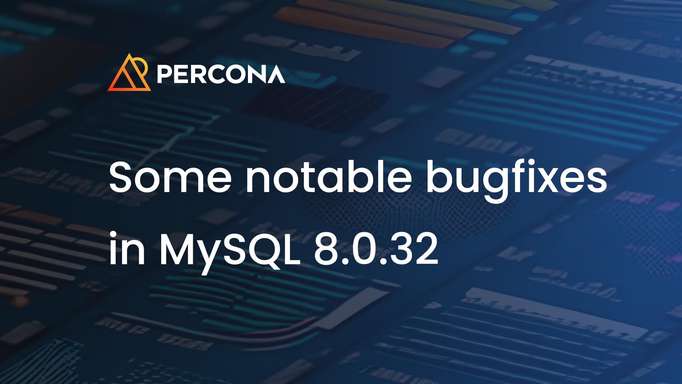If you read - Using the JSON data type with MySQL 8 - Part I, you will see that inserting data into MySQL of JSON type is a very common and effective practice. Now we’ll see how to do it with a Python project, using SQLAlchemy and Docker Compose, which further automates this example. You can run this example using a single command: docker-compose up
Before getting down to work, we will review some important concepts:
- Percona Server for MySQL is an open source, drop-in replacement for MySQL Community that provides better performance, more scalability, and enhanced security features.
- SQLAlchemy is a library that allows us to communicate between Python programs and databases.
- Docker Compose is a tool for defining and running multi-container Docker applications.
Let’s start with the structure of this project:

We have a folder called app which contains the db.py file, and this is where we create the library database and establish the connection with this database.
db_user = os.environ['DB_USER']
db_password = os.environ['DB_PASSWORD']
engine = create_engine(f"mysql+pymysql://{db_user}:{db_password}@db:3306/library")
In this file, we also create the class transactions. This will create the fields for the library databases with SQLAlchemy; we define the attributes, and they will be the database fields. We have four attributes: book_id, tittle, publishes, and labels. The last one (labels) of JSON data type.
class transactions(base):
__tablename__ = 'book'
book_id = Column(Integer, primary_key=True)
title = Column(String(50))
publisher = Column(String(50))
labels = Column(JSON)
def __init__(self, book_id, title, publisher, labels):
self.book_id = book_id
self.title = title
self.publisher = publisher
self.labels = labels
base.metadata.create_all(engine)
Now let’s review the Python script called insert.py, where we use the transactions class to insert data into the database.
import db
from sqlalchemy.orm import sessionmaker
Session = sessionmaker(bind=db.engine)
session = Session()
tr1 = db.transactions(1,'Green House', 'Joe Monter', '{"about" : {"gender": "action", "cool": true, "notes": "labeled"}}')
session.add(tr1)
session.commit()
Now let’s explore the docker-compose.yaml file, we have two services, the db and the api
version: "3.8"
services:
api:
build: .
container_name: api
depends_on:
db:
condition: service_healthy
db:
image: percona/percona-server:8.0
container_name: db
restart: always
environment:
MYSQL_USER: root
MYSQL_ROOT_PASSWORD: root
MYSQL_DATABASE: library
healthcheck:
test: ["CMD", "mysqladmin", "ping", "-h", "localhost"]
timeout: 20s
retries: 10
volumes:
- my-db:/var/lib/mysql
ports:
- "3306:3306"
expose:
- "3306"
# Names for volume
volumes:
my-db:
The db service uses the Percona Server for MySQL image (percona/percona-server:8.0) for the database and has a healthcheck that allows you to confirm when the database is started and ready to receive requests. The api service depends on the db service to start. The api service will build a Dockerfile, it does a build of the Python applications (of db.py and insert.py), so in this way, we can insert data into the database when it is ready.
It’s time to see the example in action; let’s locate it inside the json-mysql project and run docker-compose ps -d
Once this is done, we can connect to the database and query the table without needing to go inside the container with the following command:
docker exec -i db mysql -uroot -proot <<< "use library;show tables;select \* from book;describe book;"
We can check the data types of our fields and the inserted data. You will also see the JSON data type “labels” data type.
book_id title publisher labels
1 Green House Joe Monter "{\\"about\\" : {\\"gender\\": \\"action\\", \\"cool\\": true, \\"notes\\": \\"labeled\\"}}"
2 El camino Daniil Zotl "{\\"about\\" : {\\"gender\\": \\"documental\\", \\"cool\\": true, \\"notes\\": \\"labeled\\"}}"
3 London Bridge Mario Mesa "{\\"about\\" : {\\"gender\\": \\"drama\\", \\"cool\\": true, \\"notes\\": \\"labeled\\"}}"
Field Type Null Key Default Extra
book_id int NO PRI NULL auto_increment
title varchar(50) YES NULL
publisher varchar(50) YES NULL
labels json YES NULL
Use “docker compose ps” to see your services running. In this case, we have the “db” service running, which is for the database, and we have “api” with the state “exited,” which means that the scripts to create the database and insert the data into the database “library” was created.
NAME COMMAND SERVICE STATUS PORTS
api "/bin/sh -c 'bash -C…" api exited (0)
db "/docker-entrypoint.…" db running (healthy) 0.0.0.0:3306->3306/tcp, 33060/tcp
It was an example of inserting JSON data into MySQL using SQLAlchemy in Python and docker-compose for deployment.
You can find the project on GitHub. If there is any other way to make it better happy to hear it so I can improve this project.
You can explore more about Percona Server for MySQL, and if you want to see how this project start check Using the JSON data type with MySQL 8 - Part I ∎




Discussion
We invite you to our forum for discussion. You are welcome to use the widget below.